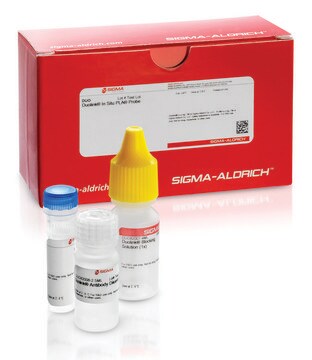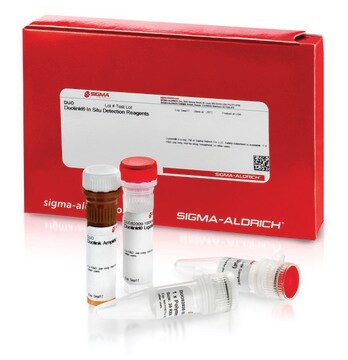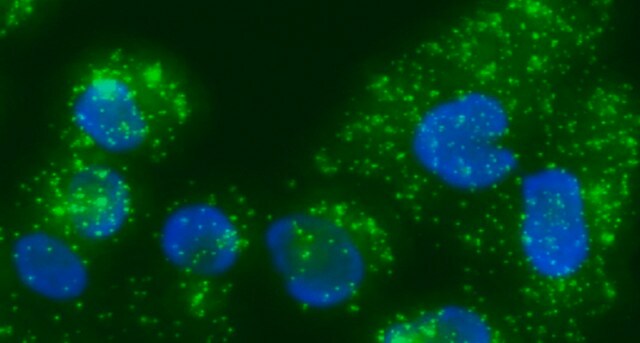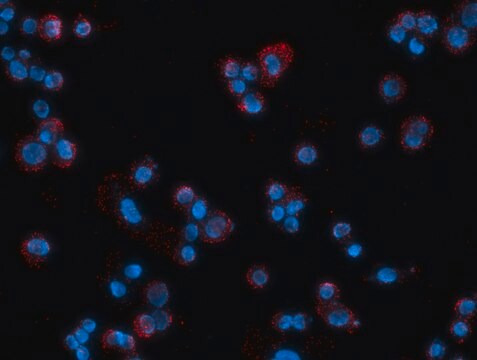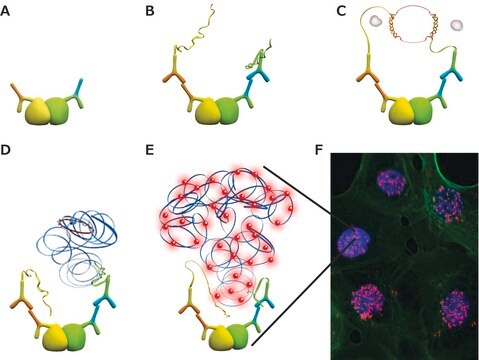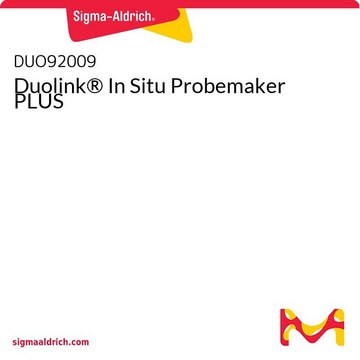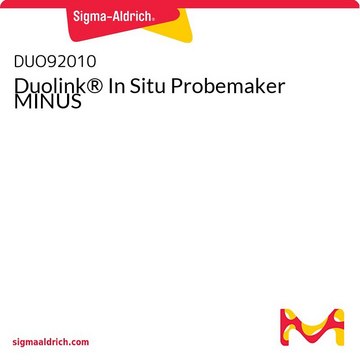DUO92008
Duolink® In Situ Detection Reagents Red
Synonim(y):
Odczynnik do testu interakcji białko-białko, Odczynnik do testu ligacji zbliżeniowej in situ
About This Item
Polecane produkty
linia produktu
Duolink®
metody
proximity ligation assay: suitable
fluorescencja
λex 594 nm; λem 624 nm (Texas Red®, Zeiss Filter set 31)
przydatność
suitable for fluorescence
Warunki transportu
dry ice
temp. przechowywania
−20°C
Powiązane kategorie
Zastosowanie
Follow the Duolink® In Situ Fluorescence Protocol to use this product. A set of short instructionsis also available.
Visit our Duolink® PLA Resource Center for information on how to run a Duolink® experiment, applications, troubleshooting, and more.
To perform a complete Duolink® PLA in situ experiment you will need two primary antibodies (PLA, IHC, ICC or IF validated) that recognize two target epitopes. Other necessary reagents include a pair of PLA probes from different species (one PLUS and one MINUS), detection reagents, wash buffers, and mounting medium. Note that the primary antibodies must come from the same species as the Duolink® PLA probes. Analysis is carried out using standard immunofluorescence assay equipment.
Red fluorescence detection reagents are often used with Texas Red® filter.
Application Note
Two primary antibodies raised in different species are needed. Test your primary antibodies (IgG-class, mono- or polyclonal) in a standard immunofluorescence (IF), immunohistochemistry (IHC) or immunocytochemistry (ICC) assay to determine the optimal fixation, blocking, and titer conditions. Duolink® in situ reagents are suitable for use on fixed cells, cytospin cells, cells grown on slide, formalin-fixed, paraffin embedded (FFPE), or tissue (fresh or frozen). No minimum number of cells is required.
Let us do the work for you, learn more about our Custom Service Program to accelerate your Duolink® projects
View full Duolink® product list
Cechy i korzyści
- No overexpression or genetic manipulation required
- High specificity (fewer false positives)
- Single molecule sensitivity due to rolling circle amplification
- Relative quantification possible
- No special equipment needed
- Quicker and simpler than FRET
- Increased accuracy compared to co-IP
- Publication-ready results
Komponenty
- 5x Ligation - Contains oligonucleotides that hybridize to the PLA probes and all components needed for ligation except the Ligase
- 1x Ligase (1 unit/μL)
- 1x Polymerase (10 units/μL)
See datasheet for more information.
Not included in Detection kit:
Primary antibodies, PLA probes, wash buffers, mounting medium
Informacje prawne
produkt powiązany
Hasło ostrzegawcze
Danger
Zwroty wskazujące rodzaj zagrożenia
Zwroty wskazujące środki ostrożności
Klasyfikacja zagrożeń
Resp. Sens. 1
Kod klasy składowania
10 - Combustible liquids
Wybierz jedną z najnowszych wersji:
Masz już ten produkt?
Dokumenty związane z niedawno zakupionymi produktami zostały zamieszczone w Bibliotece dokumentów.
Klienci oglądali również te produkty
Produkty
Białka wchodzą w interakcje z różnymi cząsteczkami, w tym z innymi białkami, aby spełniać złożone funkcje komórkowe w systemach biologicznych.
Protocol for immunofluorescent detection of proteins in cells and tissue
Dowiedz się, jak działa technologia Proximity Ligation Assay i jak zestaw kontrolny interakcji białko-białko może potwierdzić wykrywanie in situ dimeryzacji EGFR-HER2 indukowanej przez EGF.
Find Duolink references based on the type of method used, post translational modification detected, and research focus.
Protokoły
Niniejszy protokół opisuje sposób przeprowadzania immunofluorescencyjnego wykrywania białek w komórkach i tkankach.
This page details the Duolink® In Situ Short Protocol for fluorescence detection
Nasz zespół naukowców ma doświadczenie we wszystkich obszarach badań, w tym w naukach przyrodniczych, materiałoznawstwie, syntezie chemicznej, chromatografii, analityce i wielu innych dziedzinach.
Skontaktuj się z zespołem ds. pomocy technicznej